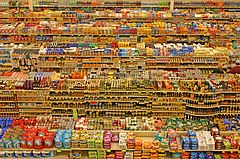From Groceries to Business Apps, Quality Suffers at One-Stop-Shops
Three years ago, I moved from the suburbs back into the city. I now live in a neighbourhood where I can walk a short distance and purchase pretty much anything I need. This area contains many culinary options: a fully-stocked grocery store, a fruit and vegetable market, three cafes, two chocolatiers, a fancy spot where you can acquire rare olive oils and jams spiked with champagne, four bakery/pastry shops (we love our baguettes up here), and a wine store (we love drinking wine while we eat our baguettes), all within the span of five short blocks.

Prior to moving here, my Saturday mornings used to be spent at a grocery store the size of a two soccer fields getting what I needed to prepare the meals for the week. My shopping habits have now changed. I rarely plan meals now, preferring to decide during the day what I’d like to eat. Also, I’ve become fiercely loyal to certain vendors.
I could buy everything at my local grocery store but instead I pick up my vegetables from the fruit and vegetable market because they are fresher. I purchase my coffee at a tiny third-wave coffee shop because I like the fact that their coffee beans aren’t roasted to the point of carbonization. I buy my croissants and baguettes from the pastry shop where everyone greets me in French (even though they are all Anglophones) because it helps me pretend I’m in Paris, which makes me very very happy.
One-stop shopping just isn’t my thing anymore, and I’m glad. I think I get better products and services from these individual vendors than I can get from one big food hypermarket.
Software suites are the big-box stores of business software
Buy a talent management suite and you’ll typically get all types of things including software for workforce planning, talent acquisition and onboarding, learning management, and succession planning, among many others. Unfortunately, just as the lettuce trucked in from some faraway mega-farm to be sold by your local mega-store may not be as fresh as the local produce sold by your corner veggie market, the components in suites may not be best-of-breed when compared to similar standalone applications.

Rather than settling for the trade-off of suites, you’re better off acquiring the best business applications and ensuring that they can share data with each other. Even IT service companies, which rely on complex technologies to stay in business, are predicting the extinction of big multi-purpose platforms in favor of niche applications that integrate with one another.
Two approaches to data sharing
Data sharing between your business applications can typically occur in real time or scheduled for a specific time each day. Real-time data sharing is typically done using an API and allows, for example, an immediate glimpse of a learner's course progress information from within, say, an HR system, even if the learner has finished a course a minute earlier.
For large-scale data sets consisting of thousands of records, a more common approach is a scheduled—rather than real-time—transfer of data. In this type of scenario, data is exported to a file by one application to be retrieved and automatically imported into the second application. This batch processing approach can still produce timely reporting since the data transfer can take place many times per day.
The real-time approach using an API typically requires some involvement from your IT team. The schedule data transfer approach is typically simpler and just requires that reports be set up and automatically generated. Regardless of which approach you select, you'll likely end up feeling pretty smug that you're using great applications that can speak to each other rather than so-so components that were bundled into a suite.
Try Absorb LMS for yourself and see what it can do. Sign up for a free instant demo portal of the learner interface and our team will help set you up with full software sandbox access.





